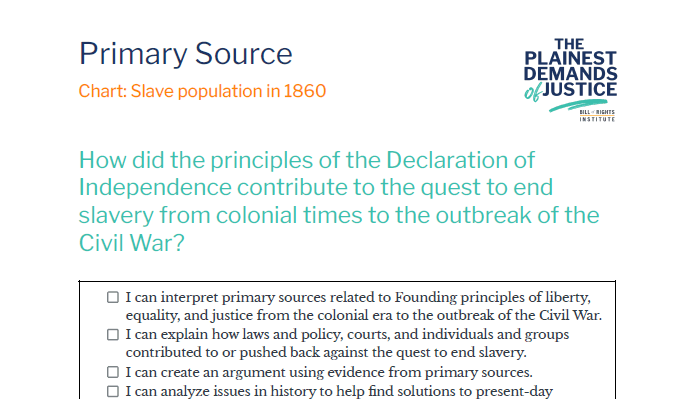Chart: Slave population in 1860
How did the principles of the Declaration of Independence contribute to the quest to end slavery from colonial times to the outbreak of the Civil War?
- I can interpret primary sources related to Founding principles of liberty, equality, and justice from the colonial era to the outbreak of the Civil War.
- I can explain how laws and policy, courts, and individuals and groups contributed to or pushed back against the quest to end slavery.
- I can create an argument using evidence from primary sources.
- I can analyze issues in history to help find solutions to present-day challenges.
Building Context
The U.S. Census Bureau counts the number of people living in the United States every 10 years. The data collected are used to calculate the number of seats given to each state in the U.S. House of Representatives. The population numbers from the 1860 census are shown below.
Slave population in 1860 chart
Source: https://en.wikipedia.org/wiki/1860_United_States_census
| No. | States | Free Population | Slave Population | Total | Percentage of Slaves |
|---|---|---|---|---|---|
| 1 | South Carolina | 301,271 | 402,541 | 703,812 | 57.2 |
| 2 | Mississippi | 354,700 | 436,696 | 791,396 | 55.2 |
| 3 | Louisiana | 376,280 | 333,010 | 709,290 | 47.0 |
| 4 | Alabama | 529,164 | 435,132 | 964,296 | 45.1 |
| 5 | Florida | 78,686 | 61,753 | 140,439 | 43.9 |
| 6 | Georgia | 595,097 | 462,232 | 1,057,329 | 43.7 |
| 7 | North Carolina | 661,586 | 331,081 | 992,667 | 33.4 |
| 8 | Virginia | 1,105,192 | 490,887 | 1,596,079 | 30.7 |
| 9 | Texas | 421,750 | 180,682 | 602,432 | 30.0 |
| 10 | Arkansas | 324,323 | 111,104 | 435,427 | 25.5 |
| 11 | Tennessee | 834,063 | 275,784 | 1,109,847 | 24.8 |
| 12 | Kentucky | 930,223 | 225,490 | 1,155,713 | 19.5 |
| 13 | Maryland | 599,846 | 87,188 | 687,034 | 12.7 |
| 14 | Missouri | 1,067,352 | 114,965 | 1,182,317 | 9.7 |
| 15 | Delaware | 110,420 | 1,798 | 112,218 | 1.6 |
| 8,289,953 | 3,950,343 | 12,240,296 | 32.2 |
Slave Population in 1860 Map

Comprehension and Analysis Questions
- According to this data, was slavery confined to the South? Explain.
- Delaware, Maryland, Kentucky, and Missouri were known as “border states” during the Civil War. Based on the chart above, why was this significant?
